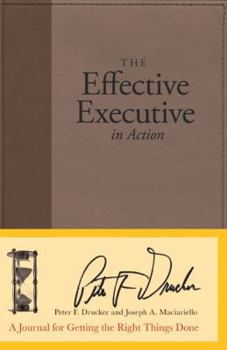The Effective Executive in Action: A Journal for Getting the Right Things Done
Select Format
Select Condition 
Book Overview
The Effective Executive in Action is a journal based on Peter F. Drucker's classic and preeminent work on management and effectiveness -- The Effective Executive . Here Drucker and Maciariello provide... This description may be from another edition of this product.
Format:Hardcover
Language:English
ISBN:0060832622
ISBN13:9780060832629
Release Date:December 2005
Publisher:Harper Business
Length:224 Pages
Weight:1.27 lbs.
Dimensions:0.8" x 6.3" x 9.3"
Related Subjects
Business Business & Investing Economics Leadership Management Management & Leadership MotivationalCustomer Reviews
5 ratings
It Is Effective
Published by Thriftbooks.com User , 14 years ago
Drucker's book covers basic business strategies for all occasions. Excellent book for all business majors, and business people.
Drucker lives on
Published by Thriftbooks.com User , 18 years ago
This is a great tool for any working executive. It's old fashioned in the sense that you have to think and then act. I would recommend it to anyone in a management position or a potential management position.
The Effective Executive In Action
Published by Thriftbooks.com User , 18 years ago
The most important workbook a leader will ever use. Essential for any leadership development program, MBA, business student, and all executives. This will change your life - just use it.
For the Reflective Practicioner
Published by Thriftbooks.com User , 18 years ago
This journal is just that...a personal journal. It guides you through several thought provoking scenarios and asks you how you feel, think, what you will/can do, etc. If you do not like to think, this is not a product you will enjoy. If, however, you enjoy noodling over your own thoughts, actions, feelings, and working through them to a plan for personal/professional development, this is a must buy item. Drucker is someone who yields more and more every time you read him. This journal will help you collect a rich harvest of useable ideas.
The Effective Executive by Peter Drucker et.
Published by Thriftbooks.com User , 18 years ago
The author has written another classic on the dynamics of executive management. The book suggests that organizations and the people who run them need to assess what must be done as a condition precedent to directing their energies productively. Time is the classic limiting factor. It applies to the activities of everyone in the organization. The effective use of discretionary time is another important asset. The success of organizations over time is dependent upon an uneventful transition strategy together with the ability to continue the business as a going concern. In Accounting, the Quasi- Reorganization in bankruptcy provides the needed second chance for organizations to start over again- although standard reporting requirements call for dating the retained earnings into the future. Companies having extensive overseas operations and outsourcing must be more vigilant about disaster recovery and contingency planning for random Acts of G-d. These unplanned emergencies may consist of a tsunami, earthquake or expropriation in countries where the political infrastructure is fragile or unpredictable. The author suggests that the organization give much thought into choosing people and assignments to optimize organizational strengths rather than magnifying weaknesses for short term gain. Ultimately, maximizing strengths renders weaknesses to be irrelevant. Each job should be structured to accommodate the personality of the occupant(s). Accordingly, this strategy will go a long way toward perpetuating the organization well into the future. In addition, training and development of staff is an important aspect of work. These activities will provide threshold competencies so that employees can function maximally. In addition, training assists in the development of successor employees due to retirements, job transfers etc. With the right people matched to the right jobs, an organization can move forward. In addition, maximization of an individual's strengths obviates the necessity for the classic flight/fight phenomena in an organization. In implementation, the management philosophy aims to accentuate strengths rather than exploit weaknesses which may result in a sum zero conflict. This rendition does not emphasize the optimal organizational design to accomplish work, although the dynamics may vary from firm to firm. Organizational conflicts may be reduced by looking at the following options dispassionately: - considering the flat organizational hierarchy with less vertical integration, where possible - controlling predictor information more carefully - completing a comprehensive job and task analysis for all company positions and vital job categories in particular - standardizing complex operations and codifying knowledge so that expertise is not a barrier to performing a job within a shorter learning curve ( today artifical intelligence systems and expert system algorithms may help accomplish this task) - transferring employees within





